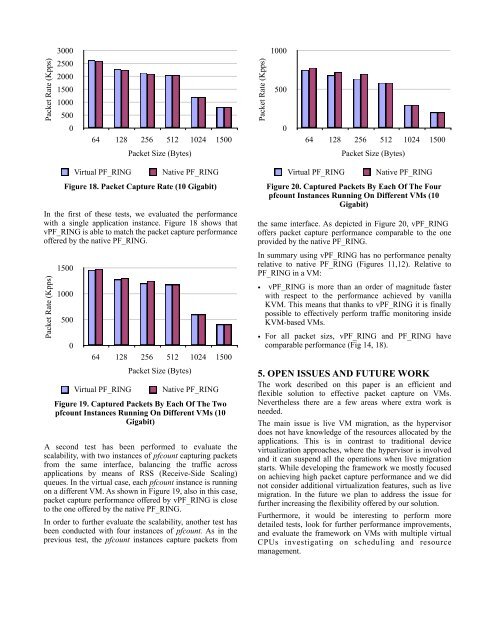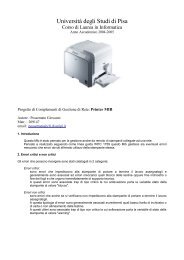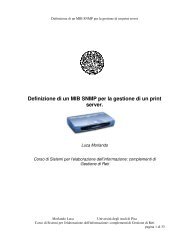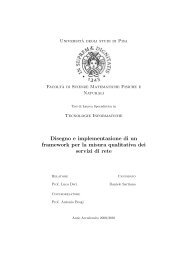vPF_RING: Towards Wire-Speed Network ... - Luca Deri - Ntop
vPF_RING: Towards Wire-Speed Network ... - Luca Deri - Ntop
vPF_RING: Towards Wire-Speed Network ... - Luca Deri - Ntop
Create successful ePaper yourself
Turn your PDF publications into a flip-book with our unique Google optimized e-Paper software.
Packet Rate (Kpps)<br />
In the first of these tests, we evaluated the performance<br />
with a single application instance. Figure 18 shows that<br />
<strong>vPF</strong>_<strong>RING</strong> is able to match the packet capture performance<br />
offered by the native PF_<strong>RING</strong>.<br />
Packet Rate (Kpps)<br />
3000<br />
2500<br />
2000<br />
1500<br />
1000<br />
500<br />
0<br />
64 128 256 512 1024 1500<br />
Figure 18. Packet Capture Rate (10 Gigabit)<br />
1500<br />
1000<br />
500<br />
0<br />
Packet Size (Bytes)<br />
Virtual PF_<strong>RING</strong> Native PF_<strong>RING</strong><br />
64 128 256 512 1024 1500<br />
Packet Size (Bytes)<br />
Virtual PF_<strong>RING</strong> Native PF_<strong>RING</strong><br />
Figure 19. Captured Packets By Each Of The Two<br />
pfcount Instances Running On Different VMs (10<br />
Gigabit)<br />
A second test has been performed to evaluate the<br />
scalability, with two instances of pfcount capturing packets<br />
from the same interface, balancing the traffic across<br />
applications by means of RSS (Receive-Side Scaling)<br />
queues. In the virtual case, each pfcount instance is running<br />
on a different VM. As shown in Figure 19, also in this case,<br />
packet capture performance offered by <strong>vPF</strong>_<strong>RING</strong> is close<br />
to the one offered by the native PF_<strong>RING</strong>.<br />
In order to further evaluate the scalability, another test has<br />
been conducted with four instances of pfcount. As in the<br />
previous test, the pfcount instances capture packets from<br />
Packet Rate (Kpps)<br />
1000<br />
500<br />
0<br />
64 128 256 512 1024 1500<br />
Packet Size (Bytes)<br />
Virtual PF_<strong>RING</strong> Native PF_<strong>RING</strong><br />
Figure 20. Captured Packets By Each Of The Four<br />
pfcount Instances Running On Different VMs (10<br />
Gigabit)<br />
the same interface. As depicted in Figure 20, <strong>vPF</strong>_<strong>RING</strong><br />
offers packet capture performance comparable to the one<br />
provided by the native PF_<strong>RING</strong>.<br />
In summary using <strong>vPF</strong>_<strong>RING</strong> has no performance penalty<br />
relative to native PF_<strong>RING</strong> (Figures 11,12). Relative to<br />
PF_<strong>RING</strong> in a VM:<br />
• <strong>vPF</strong>_<strong>RING</strong> is more than an order of magnitude faster<br />
with respect to the performance achieved by vanilla<br />
KVM. This means that thanks to <strong>vPF</strong>_<strong>RING</strong> it is finally<br />
possible to effectively perform traffic monitoring inside<br />
KVM-based VMs.<br />
• For all packet sizs, <strong>vPF</strong>_<strong>RING</strong> and PF_<strong>RING</strong> have<br />
comparable performance (Fig 14, 18).<br />
5. OPEN ISSUES AND FUTURE WORK<br />
The work described on this paper is an efficient and<br />
flexible solution to effective packet capture on VMs.<br />
Nevertheless there are a few areas where extra work is<br />
needed.<br />
The main issue is live VM migration, as the hypervisor<br />
does not have knowledge of the resources allocated by the<br />
applications. This is in contrast to traditional device<br />
virtualization approaches, where the hypervisor is involved<br />
and it can suspend all the operations when live migration<br />
starts. While developing the framework we mostly focused<br />
on achieving high packet capture performance and we did<br />
not consider additional virtualization features, such as live<br />
migration. In the future we plan to address the issue for<br />
further increasing the flexibility offered by our solution.<br />
Furthermore, it would be interesting to perform more<br />
detailed tests, look for further performance improvements,<br />
and evaluate the framework on VMs with multiple virtual<br />
CPUs investigating on scheduling and resource<br />
management.






